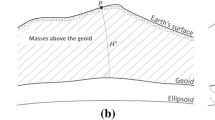Abstract
The determination of the gravimetric geoid is based on the magnitude of the gravity observed at the topographic surface of the Earth. In order to satisfy Laplace’s equation, the masses between the surface of the Earth and the geoid must be removed or shifted inside the geoid. Then the gravity values have to be reduced to the geoid, forming the boundary values on the boundary surface. Gravity reduction techniques using unclassified Digital Terrain Models (DTM) usually presume that negative elevations are reserved for ocean stations. In case of Qattara Depression, the elevations are negative, i.e., below sea level. This leads to an obvious error in the topographic-isostatic reduction using, for example, TC-program employing unclassified DTM by assuming water masses filling the depression instead of air, besides computing at the non-existing sea level instead of computing at the actual negative topography. The aim of this paper is to determine the effect of Qattara Depression on gravity reduction and geoid computation, as a prototype of the effect of the unclassified land depressions on gravity reduction and geoid determination. The results show that the effect of Qattara Depression on the gravity reduction reaches 20 mGal and is restricted only to the depression area, while its effect on the geoid exceeds 1 m and has a regional effect which extends over a distance of about 1000 km.
Similar content being viewed by others
References
Abd-Elmotaal H.A., 1998. An alternative capable technique for the evaluation of geopotential from spherical harmonic expansions. Bollettino di Geodesia e Scienze Affini, 57, 25–38.
Abd-Elmotaal H.A., 2017. Gravimetric geoid for Egypt implementing Moho depths and optimal geoid fitting approach. Stud. Geophys. Geod, 61, 657–674, DOI https://doi.org/10.1007/s11200-015-1258-2.
Abd-Elmotaal H.A. and Kühtreiber N., 1999. Improving the geoid accuracy by adapting the reference field. Phys. Chem. Earth A, 24, 53–59.
Abd-Elmotaal H.A. and Kühtreiber N., 2003. Geoid determination using adapted reference field, seismic Moho depths and variable density contrast. J. Geodesy, 77, 77–85.
Abd-Elmotaal H.A. and Kühtreiber N., 2014. The effect of DHM resolution in computing the topographic-isostatic harmonic coefficients within the window technique. Stud. Geophys. Geod, 58, 41–55, DOI https://doi.org/10.1007/s11200-012-0231-6.
Abd-Elmotaal H.A. and Kühtreiber N., 2015. On the computation of the ultra-high harmonic coefficients of the topographic-isostatic masses within the data window. Geophys. Res. Abs., 17, 355, http://meetingorganizer.copernicus.org/EGU2015/EGU2015-355.pdf
Abd-Elmotaal H.A., Abd-Elbaky M. and Ashry M., 2016. 30 meters digital height model for Egypt. Presented at the VIII Hotine-Marussi Symposium, Rome, Italy, June 17–22, 2013. https://www.researchgate.net/publication/273143491_30_Meters_ Digital_Height_Model_for_Egypt.
Abd-Elmotaal H.A., Makhloof A., Abd-Elbaky M. and Ashry M., 2017. The African 3″ × 3″ DTM and its validation. In: Vergos G.S., Pail R. and Barzaghi R. (Eds), International Symposium on Gravity, Geoid and Height Systems 2016. International Association of Geodesy Symposia 148. Springer, Cham, Switzerland, 79–86, DOI https://doi.org/10.1007/1345_2017_19.
Abd-Elmotaal H.A., Makhloof A., Hassan A. and Ashry M., 2018. Impact of Nasser Lake on gravity reduction and geoidal heights for Egypt. NRIAG J. Astron. Geophys., 7, 40–46, DOI: https://doi.org/10.1016/j.nrjag.2018.02.005.
Abd-Elmotaal H.A., Seitz K., Ashry M. and Heck B., 2020. Effect of great lakes on gravity reduction and geoid determination: case study for Lake Victoria, Africa. J. Geodesy, in print.
Forsberg R., 1984. A Study of Terrain Reductions, Density Anomalies and Geophysical Inversion Methods in Gravity Field Modelling. Report 355, Department of Geodetic Science and Surveying, Ohio State University, Columbus, OH.
Haagmans R., de Min E. and van Gelderen M., 1993. Fast evaluation of convolution integrals on the sphere using 1D FFT, and a comparison with existing methods for Stokes’ integral. Manuscripta Geodaetica, 18, 227–241.
Heiskanen W.A. and Moritz H., 1967. Physical Geodesy. Freeman & Co., San Francisco, CA.
Rapp R.H., 1982. A Fortran Program for the Computation of Gravimetric Quantities from High Degree Spherical Harmonic Expansions. Report 334. Department of Geodetic Science and Surveying, Ohio State University, Columbus, OH.
Sideris M.G. and Li Y.C., 1993. Gravity field convolutions without windowing and edge effects. Bull Geod., 67, 107–118, DOI https://doi.org/10.1007/BF01371374.
Strang van Hees G, 1990. Stokes formula using fast fourier techniques. Manuscripta Geodaetica, 15, 235–239.
Tscherning C.C., Rapp R.H. and Goad C., 1983. A comparison of methods for computing gravimetric quantities from high degree spherical harmonic expansions. Manuscripta Geodaetica, 8, 249–272.
Tscherning C.C., Knudsen P. and Forsberg R., 1994. Description of the GRAVSOFT Package. Technical Report. Geophysical Institute, University of Copenhagen, Copenhagen, Denmark.
Acknowledgements
The support by the International Association of Geodesy (IAG) and the International Union of Geodesy and Geophysics (IUGG) is kindly acknowledged. The authors would like to thank Dr. Petr Holota (the editor of this paper) and the anonymous reviewers for their useful suggestions and critical comments.
Author information
Authors and Affiliations
Corresponding author
Rights and permissions
About this article
Cite this article
Abd-Elmotaal, H.A., Kühtreiber, N. Effect of Qattara Depression on gravity and geoid using unclassified digital terrain models. Stud Geophys Geod 64, 186–201 (2020). https://doi.org/10.1007/s11200-018-1240-x
Received:
Revised:
Accepted:
Published:
Issue Date:
DOI: https://doi.org/10.1007/s11200-018-1240-x




